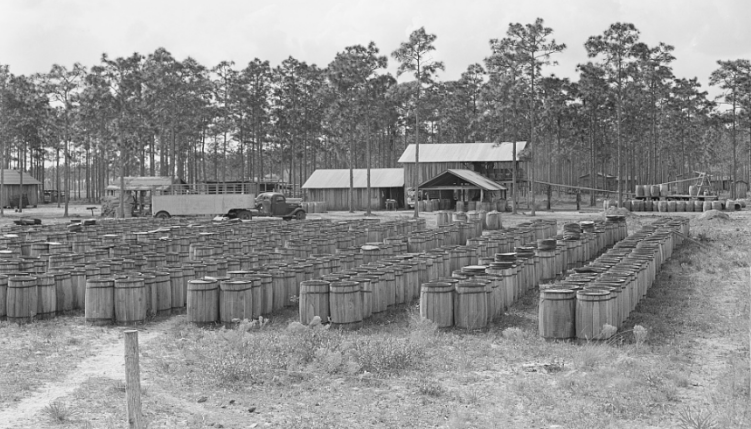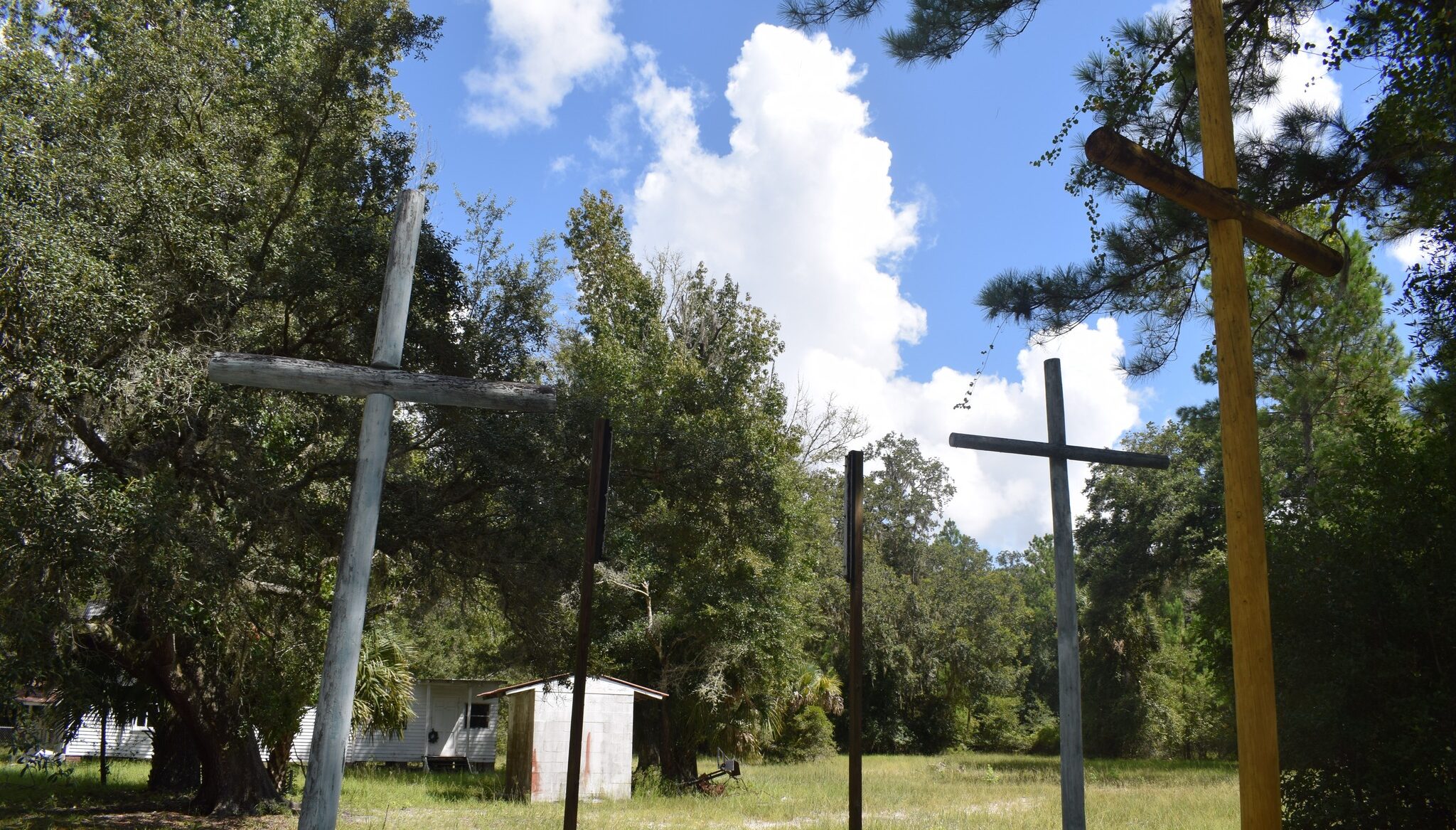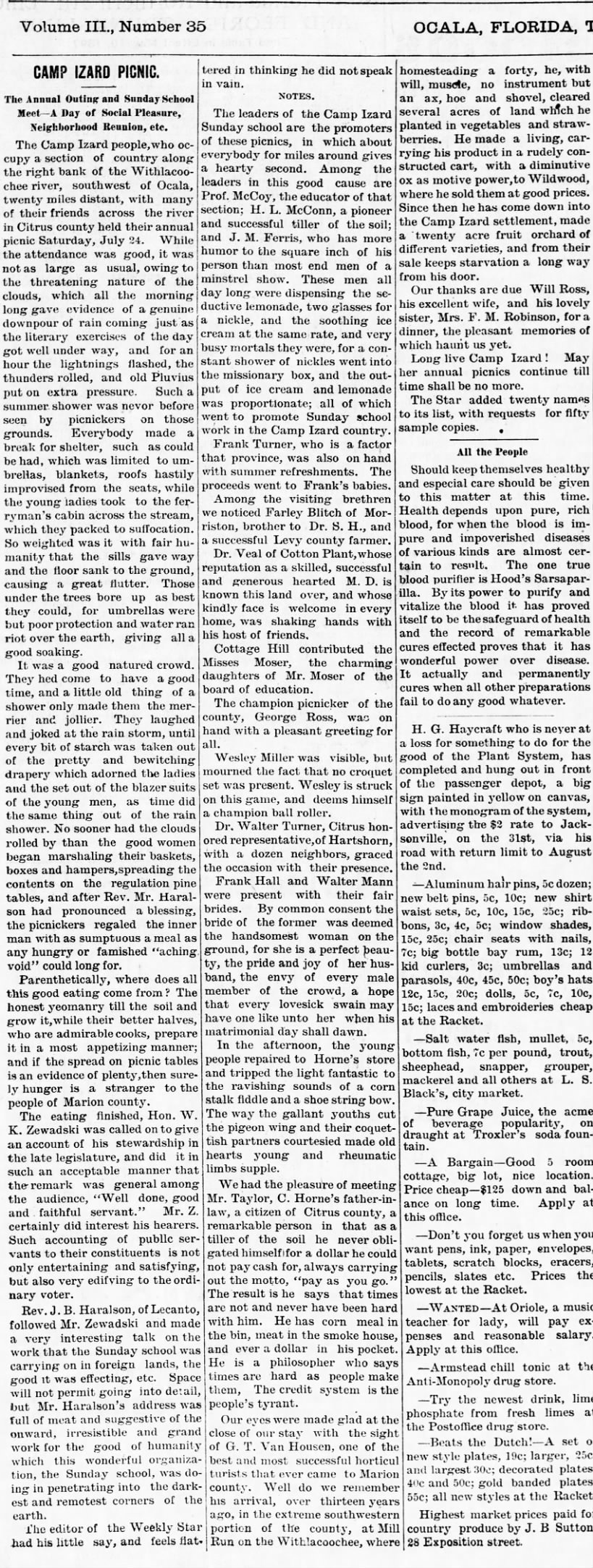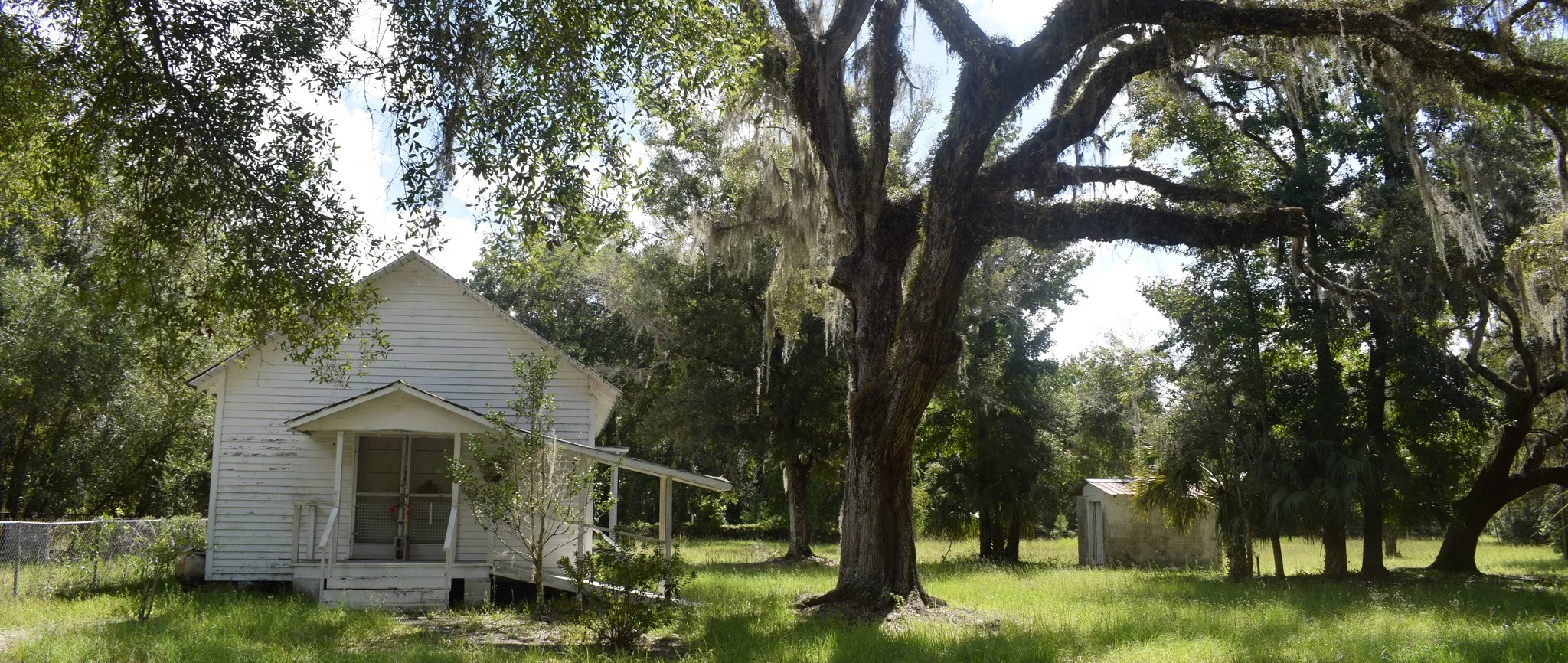
Down a winding dirt road where GPS goes silent and the pines lean in like they know something you don’t, a forgotten church and an old cemetery whisper what’s left of Gaiter. It’s not much on a map – but oh, the stories it still holds in its roots.
Gaiter Ghost Town in Florida is a fascinating slice of history tucked away along the Withlacoochee River. Imagine a small, thriving settlement where life was simple and the community strong. Gaiter is unique because it wasn’t just a standalone town but part of a quartet of interlinked communities with Cedar Grove, Camp Izard, and Stokes Ferry. Each had its vibe but came together to form a close-knit hub that was Gaiter.
I went in search of Gaiter while planning a bigger trip with Dusty. Just me, my camera, and a curiosity that wouldn’t let go. Ghost towns pull me in — not just for what’s visible, but for what lingers in the silence.
Geographically, Gaiter sits west of Ocala, and for those who fancy numbers, it’s located at 29.008539723476193 latitude and -82.34334402883613 longitude. This spot used to buzz with life and commerce thanks to the nearby settlements. Over time, Cedar Grove merged into Gaiter, weaving its identity into the town’s fabric.
The silence didn’t just settle; it leaned heavy, like it had weight and memory of its own. Peaceful, yes… but also the kind of silence that makes you wonder what it’s holding back.
Now, you might wonder what drew people to this place. Well, Florida’s landscapes, with its rivers and forests, were bountiful and nurturing. The Withlacoochee River provided both a route for transportation and a way to gather resources. The fertile land meant farming was productive, and the abundant forests fueled booming industries like turpentine production. Gaiter and its neighboring communities thrived off these natural resources.
To see more of my visit to Gaiter, watch the video below:
Of course, no place becomes meaningful without its people. Gaiter was home to hardworking folks who operated businesses, attended church services, and sent their kids to local schools like the Pine Level School. The heartbeat of the community could be heard in the local events, handshakes at the post office, and the Sunday sermons at Cedar Grove Methodist Church.
Gaiter’s story started unwrapping when Mr. S. Layton took charge as the local postmaster. His post office became the hub, connecting Gaiter and its neighbors. Today, although Gaiter might be dubbed a ‘ghost town,’ its spirit lives on in the stories, the structures that still stand, and the memories held by generations past. So, get ready for a journey through time as we explore this quaint wonder in the heart of Florida.
A Day in the Life of Gaiter

Life in the pioneer town of Gaiter wasn’t extraordinarily bustling, but it was vibrant in its own unique way. Picture a close-knit community where everyone knew each other’s names. Mr. Sidney W. Layton, the Camp Izard postmaster, was somewhat of a local hero. He ensured communication flowed smoothly among the settlements around the SR 200 bridge. His post office served as a lifeline, not just for Gaiter but also for neighboring areas. The post office was established in 1845 and closed in 1885.
Gaiter’s post office opened in 1889 and closed in 1928. The Drake family has maintained the old wooden building as a piece of Florida’s unique history. The Drake Ranch is located near Ocala, Florida. The historic ranch has been handed down through four generations of the Drake family, one of Florida’s first pioneering families to settle in Florida during the 1870s.
Cedar Grove, once an independent settlement, eventually became part of Gaiter. This merger wasn’t just a bureaucratic move but about communities weaving their lives together. Cedar Grove brought with it essential landmarks, like homes, the Cedar Grove Methodist Church, and Pine Level School. These institutions became central to the vibrant day-to-day activities in Gaiter.
The Cedar Grove Methodist Church stands out as a beacon of faith and community. Reverends like Collier and J.B. Haralson offered spiritual guidance in 1880, followed by W.C. Collins in 1885. Their sermons weren’t just religious events; they were the glue that held families and friends together.
The church wasn’t just for Sunday services. It was the venue for countless community gatherings, weddings, and town meetings. The Pine Level School was another cornerstone, educating the young minds of the area. Education was highly valued, and the school was a focal point for parents and children alike.
Homes in the Gaiter area were modest but filled with warmth and life. Families engaged in occupations ranging from farming to operating small businesses. The interconnected lives of residents at Cedar Grove, Gaiter, Camp Izard, and Stokes Ferry meant that support was always close by. Each community contributed to a shared life full of shared responsibilities and joys.
The Ties That Bound: Gaiter and Her Neighbors

Gaiter wasn’t an isolated dot on the map; it was part of a larger tapestry woven with nearby communities like Cedar Grove, Camp Izard, and Stokes Ferry. These settlements weren’t just neighbors in geography; they shared their daily lives, businesses, and dreams. An article about the Camp Izard Annual Picnic of 1897 can still be found in the 27 July 1897 issue of The Ocala Evening Star, where many Florida pioneers are mentioned, and Florida’s infamous afternoon thunderstorm raining down on the picnic. If you are a history buff, you must give this article a good read (shown at the bottom of the page).
Business and social interactions were the norm. These interconnected towns thrived on mutual support, whether trading goods, sharing farming techniques, or attending community gatherings. This type of community wasn’t just about proximity but solidarity. The residents found strength in their combined efforts, which made life a bit easier and more enjoyable.

One of the biggest businesses in the area was the turpentine still, located across Route 200. This was a massive operation back in the day. Trees were bled for their resin, which was then processed into turpentine, a valuable commodity. This industry was essential to local livelihood. Fast forward to today, and this spot has transformed into a golf course and senior community.
The community gatherings were something else. Whether it was church events at Cedar Grove Methodist Church or local fairs, these occasions were the heartbeat of social life. They offered a sense of belonging and a break from the rigors of everyday work.
Cedar Grove, Gaiter, and the neighboring settlements form a story of mutual reliance and shared experiences. Moving beyond just survival, they crafted a life filled with meaningful connections and collaborative successes. These connections hold the true essence of Gaiter and its time as a thriving community.
Where the Past Waits Patiently

When you walk through Gaiter today, you can almost hear the echoes of its past. While most of the structures have succumbed to time, a few relics still stand, keeping the spirit of the old settlement alive. It’s like stepping into a time capsule to glimpse the lives led here.
I didn’t find ghosts. I found something quieter — memory, waiting.
Among the most notable remnants is the old hand pump well, a silent reminder of the community’s once vibrant daily life. At Cedar Grove, you find the Methodist Church and the accompanying cemetery, where history rests beneath stone markers. The Cedar Grove Cemetery is not just a burial ground but a testament to the families who lived and thrived in this area.
Although it hasn’t hosted a service in years, the Cedar Grove Methodist Church is a monument to the community’s rich spiritual life. This church burned down in 1935 but was resiliently rebuilt in 1936. Standing before it, you get a sense of the dedication and faith that bound the community together.
These historic sites now reside within a hunting preserve off Route 200, west of Ocala. It’s a peaceful, protected area, giving visitors a tranquil setting to reflect on history. This preserve aids in preserving these important reminders of Gaiter’s past, ensuring they aren’t entirely lost to time.
For history buffs looking to navigate these spots, the exact location of Gaiter is at 29.008539723476193 latitude and -82.34334402883613 longitude. The Cedar Grove Methodist Church and Cemetery can be found at 13525 SW 147th Lane, Dunnellon, Florida. Visiting these sites offers a tangible sense of history and a deeper connection to those who lived and worked here.
Walking with Shadows: Visiting Gaiter Today

Walking through Gaiter Ghost Town today is quite the experience. The echoes of the past mingle with the present, creating a truly unique atmosphere. A trip here offers more than just a history lesson; it’s a chance to connect profoundly with the stories that formed this community.
One of the first stops should be the Cedar Grove Methodist Church. Despite being reconstructed in 1936 after the original burned down, it still holds the aura of its heyday. Please take a moment to stand in its presence and imagine the sermons, weddings, and community meetings that filled its space with life.
The Cedar Grove Cemetery nearby is another poignant site. It provides a quiet place to ponder the lives of those who once called this area home. The gravestones tell tales of families, challenges, and triumphs. It’s a humbling reminder of the continuity of community life from past generations to the present.
Near the gate of the cemetery, someone had left an offering: a $5 bill and an unopened bottle of wine. Two lawn chairs sat just beyond the fence, angled like they were waiting for company — or remembering someone who’d already gone.
I left the wine and the $5 untouched—some offerings aren’t meant for the living.
The old hand pump well is a tangible link to everyday activities in Gaiter. Picture families gathering water, children playing nearby, and neighbors chatting about the day ahead. It’s a simple yet powerful artifact that ties together the fragments of daily existence.
Apart from these historical sites, don’t miss the hunting preserve off Route 200. It’s not just a spot for hunters but a sanctuary preserving the essence of Gaiter. Walking through the lush landscape gives you a sense of how the town’s surroundings have remained timeless.
If you’re looking for coordinates or a map, Gaiter is located at 29.008539723476193, -82.34334402883613. The Cedar Grove Methodist Church and Cemetery are at 13525 SW 147th Lane, Dunnellon, Florida. Knowing these exact locations helps you plan your visit and ensures you don’t miss out on any significant spots. Whether you’re a history enthusiast, nature lover, or someone interested in local lore, Gaiter offers a profoundly moving experience.
Maybe this was Gaiter. Maybe it was something else entirely—folded into memory and mistaken coordinates. But the land remembers. The well still stands. And sometimes, presence speaks louder than proof.
To see all of my pictures from the ghost town of Gaiter, Florida, click here.

Murph Watch: No technical failures this time… but the long stretch of road with no signal? Yeah, Murph was definitely lurking.
The markers tell the official story.
The Companion Guide lets you write yours.🕯️🏚️

A ghost town visit is more than dates and names — it’s the way it felt to walk through what’s left. The Companion Guide gives you a place to jot down the details that matter to you.
Download it before your next lost place adventure.If you see this after your page is loaded completely, leafletJS files are missing.


Hi Ki,
As I read through your captivating account of Gaiter Ghost Town, I couldn’t help but feel a deep sense of connection to the stories and people who once called this place home. Growing up in a small town myself, I understand the importance of community and how it can shape our lives. Your description of the Cedar Grove Methodist Church and its role in the community resonated deeply with me, as I recall attending similar gatherings and events in my hometown.
I was particularly struck by the way you brought the history of Gaiter to life, highlighting the daily struggles and triumphs of its residents. Your writing has a way of transporting the reader to another time and place, making it easy to imagine the sights, sounds, and smells of this once-thriving community.
As someone passionate about history and community, I appreciate the care and attention to detail that you brought to this article. Your love for the subject matter shines through on every page, and I found myself drawn into the world of Gaiter and its people.
Thank you for sharing this fascinating story with us. I look forward to exploring more of your work and learning about the other hidden gems that Florida has to offer.
Eric
Hi Eric, thanks so much for the feedback! It sounds like we share the same passion. I, too, am fascinated by the pioneers that formed our communities and country. Living in a small town myself, I understand and feel profound sadness sometimes while walking through these ghost towns and knowing that much of that sense of community has all but vanished in the bigger cities that make up our country. I am proud that I was able to write in such a way that it connected with you and I appreciate you letting me know. I hope to be able to do that with each destination I write about. Thank you for sharing your thoughts, I truly appreciate it.
My paternal family lived in Gaiter. I have 4 generations of family buried at Cedar Grove
Hi there! Thank you for reaching out. That’s so cool to hear, Gaiter seems to have been a charming little town. Do you have any stories that were shared about Gaiter?
hi there
Thanks for sharing
I think Gaiter Ghost Town in Florida sounds like a hidden gem full of interesting stories and history, Ki! It’s always fascinating to uncover the past and learn about the lives of people who lived in these unique places. Exploring historical sites like Gaiter Ghost Town can be a great way to step back in time and appreciate the heritage of a location.
Hey, thanks for the feedback! It certainly was interesting to walk through the ghost town and experience the eeriness of a community long gone. It’s easy to forget that these pioneers got us to where we are now. Thanks for reading and sharing your thoughts!